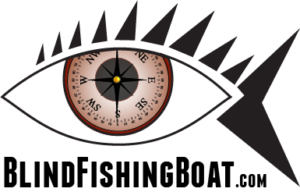Instructions on Fishing with Blind Fishers
(Visually Impaired Anglers, Vision Loss, Sight Impaired, Low Vision)
The following information will give the sighted fisher a basic level of knowledge when fishing along side a fisher with vision loss. The information is not about teaching a novice blind person to fish, but is intended to instruct sighted people about the type and level of assistance to offer when fishing with a skilled fisher with vision loss. Information is also provided on how the different duties associated with a typical fishing trip can be shared.
-If boat fishing, the non-sighted fisher will not necessarily need to bring their dog, unless it’s their own boat and they prefer to.
**Anyone considering bringing their family pet or guide dog fishing should take steps ahead of time to train the dog not to be interested in lures on fishing rods – you don’t want your dog thinking it’s time to “play ball”.**
Fishers with vision loss have their own fishing equipment and personal flotation device (PDF), but it never hurts to cheque with the person ahead of time.
Blind fishers can fish from the back of a bass boat, (a raised pedestal seat will aid by serving as a reference point).
Prior to launching the boat, Walk the blind person on to the dock and alert them to any changes to either elevation or width, or if there’s a floating dock.
Blind fishers can assist with launching by holding the line to the boat as the boat comes off the trailer.
Once on the water, describe the surrounding geography both above and below the water to the blind fisher so they have an idea of the structure to be fished.
It is not necessary to tell the blind fisher where to cast, as they will be listening to where you are casting to mark the general distance and direction.
Blind fishers normally select their own lures, tie their own knots, bait their own hooks, and release their own fish.
Describe the water clarity and type of structure that you will be fishing (e.g. weed lines, drop-offs, heavy weed cover, docks, rocks and wood, clear, stained, milky, etc.).
Blind fishers can work the landing net. Tell the blind fisher when to lower the net into the water, work your fish into the net, and then tell the blind fisher when to scoop and lift.
Tell the blind fisher if you plan on slowly working the electric trolling motor so they will no that the boat is moving.
Let the blind fisher know when it’s time to switch fishing to the other side of the boat.
Alert the blind fisher to depth changes or fish being marked below the boat.
Blind fishers are responsible for ensuring their own hooks are clear of debris.
Fishing with floats is generally not a good idea when selecting a fishing technique.
Advice on fishing techniques is generally always welcome, if not over-done.
Blind fishers are capable of taking photographs of you and your prize fish, (when posing, let the blind fisher know whether to raise, lower or move the camera right or left).
Blind fishers with driving experience can assist with loading the boat on to the trailer by driving the tow vehicle up the launch ramp several feet so the sighted person loading the boat on the trailer doesn’t have to step into the water when climbing down from the boat, (leave the tow vehicle windows open, leave the wheels in the straight ahead position, and let the blind driver know when to stop).
When loading to go, even though blind fishers are ultimately responsible for their own gear, take extra time to walk around the boat / vehicle to ensure everything is in its place.
Blind fishers are always willing to split on the costs (e.g. bait, gas, meals).
